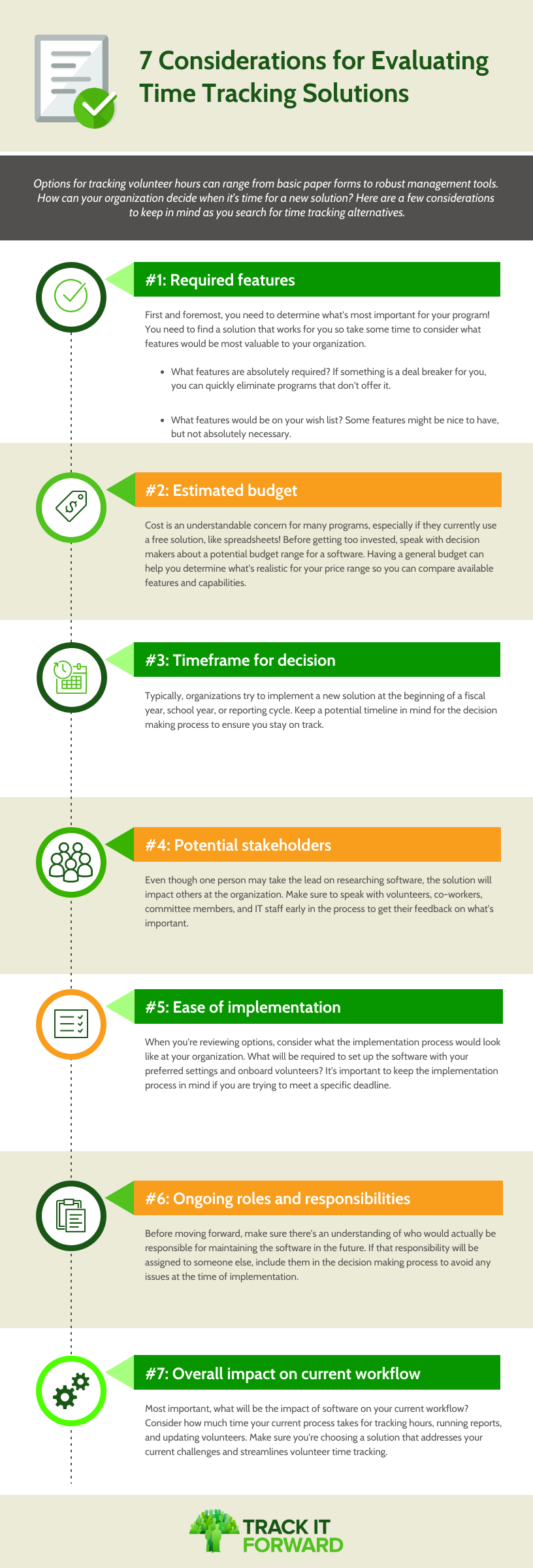
Whether you’re starting a program from scratch or trying to improve an existing system, it can be overwhelming to look for the right time tracking tool. Available tools can range from basic forms and spreadsheets to robust volunteer management systems designed for complex programs.
Before you get too far along with your search, we recommend taking a step back and consider a few key considerations.
If you are looking for more of a comprehensive guide to direct you from start to finish onfinding a volunteer software system, this article will be better for you!
1: Required features for a volunteer time tracking tool
What capabilities are most important for your volunteer program? For instance, are you tracking required service hours and need an approval process? Are you just tracking hours or do you need other capabilities, such as coordinating volunteers for events?
Consider features such as a mobile app, the option to approve volunteer hours, instantaneous reports, or an event calendar.
As you make a list of features that you hope your software can provide, decide which ones are required and which ones are more of a Wish List. If something is a deal-breaker for your organization, you can eliminate options quickly if a software doesn’t include that capability.
2: Estimate the budget for time tracking software
Cost is an understandable concern for programs, especially if they are new to time tracking or using a free tool. We recommend discussing a potential budget with managers or decision-makers early in the process so you have an idea of what’s feasible. Software with more robust features is likely to have a higher price tag so a general budget can help you set expectations for what’s realistic. You can always revisit the budget later if you determine that the features you need require a budget increase.
3. Timeframe for decision or when you would like to start tracking volunteer hours
If you’re trying to implement a new software by a specific deadline, such as the new school year, it’s important to keep that in mind. Make sure you have the necessary time available to dedicate to the research, trial, and implementation process to make your solution successful.
If you are under a strict deadline, start talking to your team early on and keep them updated on your progress. Make sure you have plenty of time to run through possible scenarios of software and see which will work best for your organization and your existing workflow.
Pro Tip: Be sure to contact sales teams for demos and walk-throughs of the software. This is typically a quick way to address key questions and make sure the software has the features you need. Talking to a sales rep can help give you a better understanding of the software and how it will work for your organization.
4. Potential stakeholders or opinions in the software
In most cases, there is one person taking the lead on researching and exploring time tracking solutions. However, it’s important that you keep other stakeholders in mind early in the process and review initial information with them. These could be potential administrators on the site, or even some key volunteers from a volunteer board. They will be using the software too!
Ask volunteers for feedback on what would be useful, speak with co-workers who will use the site, and check-in with IT about implementation concerns. Make sure everyone is on the same page with a plan to avoid getting stuck in red tape after you’ve done all the work to find the solution you need.
5. Ease of implementation
As you review options, consider what the implementation process for the new tool would look like at your organization. Is there a lengthy setup process to configure your settings and preferences? How will volunteers be added to the site and how much time will it take? If you’re trying to meet a specific deadline, it’s even more important to take the implementation process into account.
A software system is supposed to make your job easier, make sure you do not get yourself or others in too deep with confusing and time-consuming software. The correct software for your organization should fit in nicely and only take a minimal amount of time to set up and use as soon as you need it.
6. Ongoing roles and responsibilities
Once you select a time tracking tool, who will be responsible for managing it? If others will be responsible for managing certain aspects, make sure they are included in the decision-making process.
As you experience more software you may see fit to add more responsibilities to certain roles in your organization within the software. If this is something you think would be helpful in your organization, include this in your analysis of the software and think about how the software will affect and hopefully help many different roles.
It’s important to make sure that any questions or concerns are addressed prior to implementation to ensure a smooth transition for all roles and personnel involved.
7: Overall impact on current workflow
Most importantly, how do you envision a new volunteer time tracking tool impacting your current workflow? Consider how much time you currently spend tracking hours, running reports, and updating volunteers. Make sure you choose a tool that addresses the main challenges you are currently experiencing with volunteer time tracking.
Your use of software should fit nicely into your current workflow. Your job should not feel disrupted by using this software! This should be a pretty heavy consideration when thinking of software to use for your time tracking and volunteer management.
 Last updated by
Last updated by